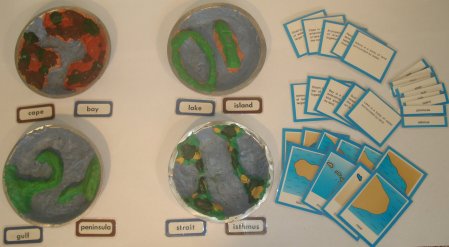Land and Water Forms
From wikisori
Contents
Age
3-6
Materials
Models representing the following forms of physical geography:
- archipelago
- system of lakes
- cape
- bay
- strait
- isthmus
- peninsula
- gulf
- island
- lake
The following additional materials:
- Water jug
- Sponge
- tray
- A set of Terminology cards of maps of the Land and Water Forms including definitions of particular land or water form. Wikisori has a free copy available for download here: Land and Water Form Terminology Cards
Preparation
This can be an individual or group presentation.
Presentation
Directress pours water into one of the forms, saying, "Look, I've made a Lake. A Lake is water surrounded by land. Would you like to make a lake?"
She pours the water back into the jug and allows the child to repeat the exercise.
Repeat for the Island.
Introduce each of the landforms in pairs.
Control Of Error
Points Of Interest
Land and Water form definitions:
- A Lake is surrounded by land.
- An Island is land surrounded by water.
- A Bay is a sea, partly enclosed by land.
- A Cape is land protruding out into the sea.
- A Gulf is sea penetrating a long way into the land.
- A Peninsula is a land jutting out into the sea.
- A strait is a narrow strip of water joining two large areas of water.
- An Isthmus is a narrow strip of land joining two large areas of land.
You can make your own land and water forms by using cake pans or sandwich containers and a non-hardening clay such as Plasteline.
Purpose
- Introduction to Land and Water forms.
- Make the child aware of the existence of the various land and water forms.
- Preparation of later systematic study of physical geography.
- Refine eye-hand coordination.
Variation

